In Search of Sasquatch
Story by Peter von Puttkamer / Photography by Julie Lee
 I can’t remember when I first developed an interest in the Big Hairy guy…maybe it was those newspaper headlines about the film of Bigfoot filmed in Northern California. It happened sometime between the Kennedy shootings. I was ten years old. What is it about the notion of a large elusive wild man in our midst that is so compelling? It always beat the UFO thing for me…I mean, this could be one of our distant cousins; it could give us some insight into our origins on the planet…then again maybe all this is wishful thinking. Some have called "Sasquatch" (a name derived from the Salish, then coined by Harrison newspaperman Ralph Burns in the 1930’s) an archetype- a vestige of a hairy man-like creature from an earlier age. A time when we lived side by side with Neanderthal, or perhaps another giant primate, such as Gigantopithecus Blacki (a giant ape whose fossils have been found in China). Then there are the eye-witness reports, the thousands of footprints worldwide…is it a conspiracy, a massive hoax…and what about that shaky 1967 film of a female Bigfoot, breasts swaying, disappearing into the brush? It is so convincing, thirty years later, people are still trying to debunk it. I can’t remember when I first developed an interest in the Big Hairy guy…maybe it was those newspaper headlines about the film of Bigfoot filmed in Northern California. It happened sometime between the Kennedy shootings. I was ten years old. What is it about the notion of a large elusive wild man in our midst that is so compelling? It always beat the UFO thing for me…I mean, this could be one of our distant cousins; it could give us some insight into our origins on the planet…then again maybe all this is wishful thinking. Some have called "Sasquatch" (a name derived from the Salish, then coined by Harrison newspaperman Ralph Burns in the 1930’s) an archetype- a vestige of a hairy man-like creature from an earlier age. A time when we lived side by side with Neanderthal, or perhaps another giant primate, such as Gigantopithecus Blacki (a giant ape whose fossils have been found in China). Then there are the eye-witness reports, the thousands of footprints worldwide…is it a conspiracy, a massive hoax…and what about that shaky 1967 film of a female Bigfoot, breasts swaying, disappearing into the brush? It is so convincing, thirty years later, people are still trying to debunk it.
 As a filmmaker, I’ve spent much of the last twenty years creating films for and about First Nations cultures. My show "The Spirit of the Mask", looked into the mysteries behind Northwest coast masks: notions of transformation, connections to the spirit and animal worlds through the vessel of the mask. A part of that show looked at the loss of European mask traditions and what that disconnection with nature has meant to our industrialized society. For several years, I had been toying with the notion of doing a show on the "Wildman" – the wild, hairy hominid who appears in cultures around the world. Wildman appears in carnivals and in the coats-of-arms of European royal families as a symbol of strength and fertility (a King of England is said to have died tragically while wearing a "wildman" costume, which caught fire during festivities). Sasquatch sightings in North America have occurred for at least two hundred years, longer if one includes the Kwakiutl mythology of Bokwus(wild man), Dzonokwa (wild woman) and other Native Indian cultures. Edmond Hillary sighted a Yeti (Abominable Snowman) in his 1952 expedition, prompting a 1953 Yeti expedition financed by the Daily Mail News in London. In 1924, an Oregon paper reported a miner Fred Beck had fought off a group of large hairy creatures at a cabin on Mt. St. Helens. Roger Patterson filmed a Sasquatch in Bluff Creek, CA in 1967; or did he? As a filmmaker, I’ve spent much of the last twenty years creating films for and about First Nations cultures. My show "The Spirit of the Mask", looked into the mysteries behind Northwest coast masks: notions of transformation, connections to the spirit and animal worlds through the vessel of the mask. A part of that show looked at the loss of European mask traditions and what that disconnection with nature has meant to our industrialized society. For several years, I had been toying with the notion of doing a show on the "Wildman" – the wild, hairy hominid who appears in cultures around the world. Wildman appears in carnivals and in the coats-of-arms of European royal families as a symbol of strength and fertility (a King of England is said to have died tragically while wearing a "wildman" costume, which caught fire during festivities). Sasquatch sightings in North America have occurred for at least two hundred years, longer if one includes the Kwakiutl mythology of Bokwus(wild man), Dzonokwa (wild woman) and other Native Indian cultures. Edmond Hillary sighted a Yeti (Abominable Snowman) in his 1952 expedition, prompting a 1953 Yeti expedition financed by the Daily Mail News in London. In 1924, an Oregon paper reported a miner Fred Beck had fought off a group of large hairy creatures at a cabin on Mt. St. Helens. Roger Patterson filmed a Sasquatch in Bluff Creek, CA in 1967; or did he?
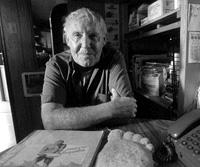 In the summer of 1997, producer Julie Lee, my wife/partner Sheera and I started talking about some ideas about a Bigfoot film. Julie had met the son of Rene Dahinden- Sasquatch hunter extrordinaire and heard his unusual stories about growing up with a dad who was a Bigfoot hunter. Rene’s the guy in the Kokanee Beer commercials and he has in fact been researching Sasquatches and Sasquatch hunters for forty years. He’s a crusty old Swiss guy and he doesn’t take bullshit from anyone. We all agreed there was something inherently interesting and funny about a guy who’s been chasing an elusive, mythical monster all his life. We talked about a lot of angles on this…how could we take a look at this Sasquatch thing with a new eye…something fresh. The more we looked into the characters involved in this thing, the more we saw the makings of an Errol Morris-style doc. Interesting people, impossible goals and a mystery to be solved. Most importantly, it had to be funny while raising profound thoughts about the possibility of our missing ancestor. In the summer of 1997, producer Julie Lee, my wife/partner Sheera and I started talking about some ideas about a Bigfoot film. Julie had met the son of Rene Dahinden- Sasquatch hunter extrordinaire and heard his unusual stories about growing up with a dad who was a Bigfoot hunter. Rene’s the guy in the Kokanee Beer commercials and he has in fact been researching Sasquatches and Sasquatch hunters for forty years. He’s a crusty old Swiss guy and he doesn’t take bullshit from anyone. We all agreed there was something inherently interesting and funny about a guy who’s been chasing an elusive, mythical monster all his life. We talked about a lot of angles on this…how could we take a look at this Sasquatch thing with a new eye…something fresh. The more we looked into the characters involved in this thing, the more we saw the makings of an Errol Morris-style doc. Interesting people, impossible goals and a mystery to be solved. Most importantly, it had to be funny while raising profound thoughts about the possibility of our missing ancestor.
Funding applications started going out before Christmas of that year and we started compiling the cast of characters. We decided early on that we would focus on the original group of Sasquatch hunters: people who have been at it for thirty years or more.
The Four Horsemen of Sasquatchery
Our research over the next few months led us to four key players- two Canadians a British/Irish ex-pat and an American. They were definitely the genuine article. These were no namby-pamby new age Bigfoot seekers. These were real men, now in their late sixties and mid-seventies who had spent a lifetime documenting, interviewing and investigating the Bigfoot Phenomenon. I discovered that three of them had all worked together on the 1960 Pacific Northwest Bigfoot expedition, funded by a Texas oil millionaire, with the unlikely name of Tom Slick. We were off to the races.
You can’t tell the players without a program:
| John Green: |
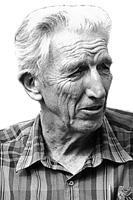 Living in Harrison Hot Springs, B.C. A no-nonsense reporter, he’s collected over 3000 sighting reports on Bigfoot; he only officially recognizes a few hundred as legit.; he wrote what some consider the Definitive Sasquatch work: "Sasquatch: The Apes Among Us" He ventured to Northern California, only days after footprints were discovered in 1958. That’s where he saw his first prints. Living in Harrison Hot Springs, B.C. A no-nonsense reporter, he’s collected over 3000 sighting reports on Bigfoot; he only officially recognizes a few hundred as legit.; he wrote what some consider the Definitive Sasquatch work: "Sasquatch: The Apes Among Us" He ventured to Northern California, only days after footprints were discovered in 1958. That’s where he saw his first prints. |
| Rene Dahinden: |
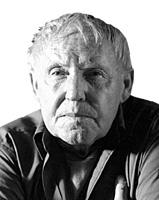 Heard about Bigfoot while working on a dairy farm in Alberta. Came out in search of an adventure, an encounter and perhaps live capture of the beast. He began his work in John Green’s Newspaper printing Shop. He has no time for fools, hates hoaxes and especially pretentious PHD’s (Rene calls them- "Please Help Demented"). Heard about Bigfoot while working on a dairy farm in Alberta. Came out in search of an adventure, an encounter and perhaps live capture of the beast. He began his work in John Green’s Newspaper printing Shop. He has no time for fools, hates hoaxes and especially pretentious PHD’s (Rene calls them- "Please Help Demented"). |
| Peter Byrne: |
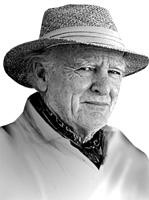 Think Stewart Granger, in his seventies, in a safari suit. Since chasing the Yeti for Texas oilman Tom Slick, in Nepal in 1956…Peter’s been known as a promoter with the ability to raise millions of dollars in the pursuit of the elusive creature. He has hundreds of collected sightings, personal footprint encounters and ran the Bigfoot Research Project in the Dalles Oregon for five years. Financed by a mysterious industrialist, Peter had thermal imaging equipment, helicopters, motion-sensors and a 1-800 Bigfoot number at his disposal to find the beast. Byrne once bribed a Tibetan monk with a bottle of scotch…so he could get at the hand of a Yeti, locked away in a monastery. Having removed a finger, Byrne stayed up all night sewing on a replacement human finger. Later actor Jimmy Stewart, an acquaintance of Byrne’s smuggled the Yeti finger out of Nepal in his wife’s lingerie bag. Think Stewart Granger, in his seventies, in a safari suit. Since chasing the Yeti for Texas oilman Tom Slick, in Nepal in 1956…Peter’s been known as a promoter with the ability to raise millions of dollars in the pursuit of the elusive creature. He has hundreds of collected sightings, personal footprint encounters and ran the Bigfoot Research Project in the Dalles Oregon for five years. Financed by a mysterious industrialist, Peter had thermal imaging equipment, helicopters, motion-sensors and a 1-800 Bigfoot number at his disposal to find the beast. Byrne once bribed a Tibetan monk with a bottle of scotch…so he could get at the hand of a Yeti, locked away in a monastery. Having removed a finger, Byrne stayed up all night sewing on a replacement human finger. Later actor Jimmy Stewart, an acquaintance of Byrne’s smuggled the Yeti finger out of Nepal in his wife’s lingerie bag. |
| Grover Krantz: |
 Professor of Physical Anthropology at Washington State University- he’s one of the only academics to ever throw his hat into the Bigfoot ring. He believes Bigfoot is descendent from the migration of Gigantopithecus Blacki from Asia (an 8 to 10 ft high gorilla, weighing 800 lbs) over the Bering Land bridge to North America thousands of years ago. He has footprints, a theory about fake tracks and is determined to shoot a Bigfoot if he can. Professor of Physical Anthropology at Washington State University- he’s one of the only academics to ever throw his hat into the Bigfoot ring. He believes Bigfoot is descendent from the migration of Gigantopithecus Blacki from Asia (an 8 to 10 ft high gorilla, weighing 800 lbs) over the Bering Land bridge to North America thousands of years ago. He has footprints, a theory about fake tracks and is determined to shoot a Bigfoot if he can. |
Finding the Dollars
November 1997-May, 1998 - Julie was busy raising dollars and selling broadcasters on the show. Space Television were the first in, followed by Baton Broadcasting, thereby giving us our broadcast license requirements. We got lucky at Telefilm Canada, a year when only a few companies in the west got funding.
The First Shoot- Sasquatch Conference
June 5-7, 1998 - we attended the annual Sasquatch Conference at the University of British Columbia. Some of our major characters would be there, along with an assorted collection of Bigfoot/UFO enthusiasts, Bigfoot Trans-channellers, and Bigfoot musicians. UBC has a bit of history when it comes to the hairy guy. It was here that the famous ’67 Patterson film had its world premiere; then in 1978 UBC hosted a legitimate scientific conference about the phenomenon: "Man-like Monsters on Trial" attended by several dozen anthropologists, authors, and hominoid experts from around the world. Since then, the event has become increasingly "less scientific", much to the chagrin of UBC officials, who asked us to avoid indentifying too many of the buildings in our shots. It was at UBC that we formed our opinion about the various Bigfoot groups: serious tracker/researchers, Bigfoot social club members, curious members of the public and of course- the bizarre personalities. One woman showed us pictures of a Bigfoot she had channeled onto a strip of film during an outing at Harrison- apparently her group regularly feeds Sasquatch a special food: the essence of apples and cabbages. Jack Laspseritis, author of "The Psychic Sasquatch" describes the big hairy ape-men as "para-physical inter-dimensional nature people".
The "Godfather" of Sasquatch Research
 May 31, 1998 - we went out to meet John Green. Considered the "Godfather of Sasquatch research" by many people, the 70-something Green met us at the Kilby Farms out at Harrison Mills. This was to be a fact-finding mission only, but little did we know we’d be drawn into our first Bigfoot close-encounter of the third kind. After a day touring the 1920’s museum/farm which John runs, that evening John received an actual "Bigfoot sighting report" from a logging camp at the far end of Harrison Lake. We were asked if we’d like to tag along and of course we jumped at the chance. May 31, 1998 - we went out to meet John Green. Considered the "Godfather of Sasquatch research" by many people, the 70-something Green met us at the Kilby Farms out at Harrison Mills. This was to be a fact-finding mission only, but little did we know we’d be drawn into our first Bigfoot close-encounter of the third kind. After a day touring the 1920’s museum/farm which John runs, that evening John received an actual "Bigfoot sighting report" from a logging camp at the far end of Harrison Lake. We were asked if we’d like to tag along and of course we jumped at the chance.
The next morning we found ourselves heading off down a dusty logging road in two vehicles. Unfortunately, the only camera we had along was Julie’s recently acquired 8mm video camera used for field notes. I was riding in Green’s old four-wheeler to get some shots of John; Sheera and Julie in the meantime were at the mercy of "Solly"- an experienced logging-truck driver and Bigfoot protégé of Green’s who was driving our reasonably-new VW Passat wagon. While John and I loped along at 60 k or so down the dusty, washboard road, Solly was off like a scared Bigfoot in my car, carrying my wife and producer. John just grinned as he saw them take off, saying: I think Sheera will be amazed at Solly’s shifting technique. When we arrived at the logging camp, I met a somewhat pale-looking Julie and Sheera. It seems that over the jarring two-hour ride, at 80 to 90 k, Solly had never once used the clutch or brake in our 5-speed wagon- instead he had matched the revs and slammed in the gears with uncanny precision. Well, he did say he knew the road. We met the logger- a bear hunter who took us out to the location of his Saquatch sighting. While hunting bear, he’d seen a human-like shape looking at him from behind a tree. He called out to it, since he could see its peaked head, a silhouette in the fading light. It never answered, but he could hear it crashing around in the bushes. Ultimately, those digitally-enhanced camcorder images we shot found there way into our show, blending seamlessly with the story.
Bigfoot Showman and the State Trooper- Bigfoot Encounters
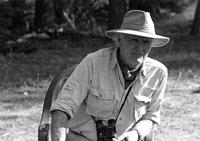 July 25, 1998 - we got an invitation from Peter Byrne to interview an Oregon state trooper who had a Bigfoot encounter 20 years ago, but had never talked about it. We packed into themini-van and headed south to The Dalles, Oregon. We met Peter Byrne in the lobby of a hotel in Portland. I was surprised but delighted to see him fully clad in his safari suit, ascot, Leica binoculars (a gift from Tom Slick) and sweat-brimmed safari hat. We drove to a little town near the Dalles, called Dufur Bend. We arrived at a classic roadside diner: fish and animal heads on the wall, pool tables and friendly waitress loaded down with triple-decker sandwiches. We met the retired trooper- Mr. Hastings and I must admit he was extremely convincing: shy, a little embarrassed by what he had seen, but nevertheless willing to pass on his story now, some twenty years later. July 25, 1998 - we got an invitation from Peter Byrne to interview an Oregon state trooper who had a Bigfoot encounter 20 years ago, but had never talked about it. We packed into themini-van and headed south to The Dalles, Oregon. We met Peter Byrne in the lobby of a hotel in Portland. I was surprised but delighted to see him fully clad in his safari suit, ascot, Leica binoculars (a gift from Tom Slick) and sweat-brimmed safari hat. We drove to a little town near the Dalles, called Dufur Bend. We arrived at a classic roadside diner: fish and animal heads on the wall, pool tables and friendly waitress loaded down with triple-decker sandwiches. We met the retired trooper- Mr. Hastings and I must admit he was extremely convincing: shy, a little embarrassed by what he had seen, but nevertheless willing to pass on his story now, some twenty years later.
|
|
|
|
|
|
|
|
When (Officer) Hastings saw the dark hair covering its body, his first thought was this must be some kind of animal, but when it turned to look at him, he noticed the eyes did not shine. Animal eyes shine at night, but not human eyes.
|
He was nervous about repercussions with his old police department and asked us to be discreet about mentioning their name. In between courses of homemade soup and impossibly huge sandwiches- he told us the story: He was travelling down a road he’d been on many times- the Dufour gap road. A strip of highway leading down an arid plain- the primeval volcanic shape of a snowcapped Mt Hood looming in the background. It was just after sunset and as he came around the corner he saw what he thought was a man down by the creek bed. When it saw him, it moved up the embankment with great speed, it did not put its arms down to balance itself. When Hastings saw the dark hair covering its body, his first thought was it must be some kind of animal- but when it turned to look at him, he noticed the eyes did not shine. Animal eyes shine at night, but not human eyes. It crossed the highway with great strides then "flowed" up the embankment on the other side. Byrne told us this was one of his best-confirmed sightings. Hastings had worked for the fish & wildlife service, had been a trained observer all his life and he knew this was no bear. Then there was the smell- often mentioned in Bigfoot sightings. Hastings said he’s hunted bear and elk- he was familiar with those smells; this was more of a human body odour type smell. I secretly wondered if it wasn’t his own BO he smelled, after such an experience. Peter Byrne surmised the critter had been looking for food and followed the creek bed down from Mt. Hood National Park- a frequent Sasquatch-sighting location. I must admit, after that encounter it had an impact on any skeptical thoughts we might have developed after the UBC Sasquatch Conference.
The Ape Cave Crawl and Bone Hunt
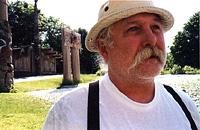 July 26, 1998 - on the way home, we meet up with Ray Crowe, President of the Western Bigfoot Society. He organized an "Ape Cave Crawl" amongst the lava tubes of Mt. St Helens. We descend into the caves, said to be the favorite hiding place of Sasquatches; some believe this is the entrance way to a "hollow earth"- a continental network of underground tunnels- a sub-terranian highway used by Sasquatch. Members of the society also go on the first annual Bone Hunt- looking for signs of Bigfoot amongst the rubble and destruction of Mt. St. Helens. We discover a "cooked critter" in the lava-debris in the stream bed, just a few miles from the crater itself. Is it Bigfoot? It’s 100 F degrees in the shade and after running back to the car for a missing camera reflector, my soundman nearly passes out, then gets sick to his stomach. July 26, 1998 - on the way home, we meet up with Ray Crowe, President of the Western Bigfoot Society. He organized an "Ape Cave Crawl" amongst the lava tubes of Mt. St Helens. We descend into the caves, said to be the favorite hiding place of Sasquatches; some believe this is the entrance way to a "hollow earth"- a continental network of underground tunnels- a sub-terranian highway used by Sasquatch. Members of the society also go on the first annual Bone Hunt- looking for signs of Bigfoot amongst the rubble and destruction of Mt. St. Helens. We discover a "cooked critter" in the lava-debris in the stream bed, just a few miles from the crater itself. Is it Bigfoot? It’s 100 F degrees in the shade and after running back to the car for a missing camera reflector, my soundman nearly passes out, then gets sick to his stomach.
Carson Bigfoot Daze and a Bigfoot Trial
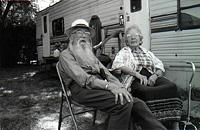 August 29-30, 1998 - Carson Bigfoot Daze, Carson, WA. This is the only county in the U.S., where it is illegal to shoot a Bigfoot. I was still up in the Tatshenshini/Kluane Park area in the Yukon filming a European Discovery Channel travel/adventure show complete with hair-raising helicopter rides and angry grizzly bears. Sheera, Julie and a crew of three headed south, jammed into a Winnebago so we could join other Bigfoot aficionados in the "Bigfoot Trailer Park". The general area around the trailer park had apparently produced a number of hairy sightings. The trailer camp was run by none other than Harry Schumacher--pronounced (nudge, nudge, wink wink) "hairy shoe-maker". I arrived on an evening flight from the Yukon, just in time to join the festivities of the "Bigfoot Stomp" complete with an outdoor band singing about you guessed it…The next day we set about filming members of the "Western Bigfoot Society" who were conducting a mock-trial to determine the fate of any human who dares shoot a Bigfoot in Skamania county. After the creature was carried in by pallbearers in a casket, big burly biker Bigfoot experts traded stories and argued with Yale scientists and nerdy collectors about the fate of the Bigfoot killer. It was very educational. August 29-30, 1998 - Carson Bigfoot Daze, Carson, WA. This is the only county in the U.S., where it is illegal to shoot a Bigfoot. I was still up in the Tatshenshini/Kluane Park area in the Yukon filming a European Discovery Channel travel/adventure show complete with hair-raising helicopter rides and angry grizzly bears. Sheera, Julie and a crew of three headed south, jammed into a Winnebago so we could join other Bigfoot aficionados in the "Bigfoot Trailer Park". The general area around the trailer park had apparently produced a number of hairy sightings. The trailer camp was run by none other than Harry Schumacher--pronounced (nudge, nudge, wink wink) "hairy shoe-maker". I arrived on an evening flight from the Yukon, just in time to join the festivities of the "Bigfoot Stomp" complete with an outdoor band singing about you guessed it…The next day we set about filming members of the "Western Bigfoot Society" who were conducting a mock-trial to determine the fate of any human who dares shoot a Bigfoot in Skamania county. After the creature was carried in by pallbearers in a casket, big burly biker Bigfoot experts traded stories and argued with Yale scientists and nerdy collectors about the fate of the Bigfoot killer. It was very educational.
The NASI Digital Experience
|
|
|
|
|
|
|
|
Ray once tried to sell Tom Slick and Peter Byrne a baby in a cage - his asking price in the early 60s - $25,000! On the next day, when the hunters asked for proof before they handed over cheque, Ray said the baby Bigfoot had gotten a cold and he had to let it go.
|
September 1, 1998 - Hood River, OR; We are at the site of the greatest accumulation of windsurfers in North America. We interview the people at NASI- no, this isn’t some kind of Ayrian nation Bigfoot society- but, the North American Science Institute who recently spent over $75,000.- to digitally analyze the now famous 1967 Patterson film of the large hairy creature, with the swaying breasts pacing off into the woods. The results were definitely inconclusive and they couldn’t say for sure if it was a man in a suit.
Terrifying Tall Tales
September 1, 1998 -somewhere in central Washington- we visit the home of Ray Wallace; known to be a bit of a Bigfoot story-teller: he was working on nearby road crews when the first Big Tracks were found in Bluff Creek, CA. Ray once tried to sell Tom Slick and Peter Byrne a baby Bigfoot in a cage- his asking price in the early ‘60’s- $25,000! On the next day, when the hunters asked for proof before they handed over their cheque, Ray said the baby Bigfoot had gotten a cold and he had to let it go. He once recorded a country and western song about Bigfoot- complete with accompanying Bigfoot screams he said he recorded while it was stuck in a trap he’d set. Now in his ‘80’s Ray was still full of it and he was excited to talk to us. He even offered to sell us film he had taken of two Bigfoot critters "eating crawdaddies down at the crick"- for $100,000! Unfortunately, before we had a chance to set up our cameras- Mrs. Wallace intervened. She’s seen a few camera crews set up in her living room over the years and it seemed her taste for the media had somewhat soured. She ordered us out of the house, despite Ray’s protests.
Kokanee Beer Ads and Gun Clubs
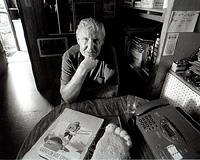 September 4, 1998 - back in Vancouver, we film Rene Dahinden at his home on the Richmond Gun Club. Rene’s had a good deal there for the last 20 years- he’s a care-taker and collects the lead shot which accumulates from the shotgun blasts out into the fields; in exchange, he gets to live there in his trailer. Various temporary buildings are filled with Sasquatch memorabilia collected over the last forty years. We talk about his passion for the critter: he was first drawn into the field when he heard about the 1953 British Daily Mail News expedition, looking for the Yeti. We talked about the controversy of the Patterson film: is it real, is it a guy in a suit, Rene’s legal battles to gain custody of the footage. Today, he owns the still and theatrical rights to the film and he’s pretty sure it’s real. At least he hasn’t heard a convincing argument which debunks the show yet. Rene says he’s seen the Bigfoot enthusiasts and their fancy new theories come and go- "they all came and they all went". Many come to him for advice and he says he feels like Einstein- "who spent forty years in complex mathematical calculations and some idiot comes along and wants to argue why two and two is four instead of twenty-two." September 4, 1998 - back in Vancouver, we film Rene Dahinden at his home on the Richmond Gun Club. Rene’s had a good deal there for the last 20 years- he’s a care-taker and collects the lead shot which accumulates from the shotgun blasts out into the fields; in exchange, he gets to live there in his trailer. Various temporary buildings are filled with Sasquatch memorabilia collected over the last forty years. We talk about his passion for the critter: he was first drawn into the field when he heard about the 1953 British Daily Mail News expedition, looking for the Yeti. We talked about the controversy of the Patterson film: is it real, is it a guy in a suit, Rene’s legal battles to gain custody of the footage. Today, he owns the still and theatrical rights to the film and he’s pretty sure it’s real. At least he hasn’t heard a convincing argument which debunks the show yet. Rene says he’s seen the Bigfoot enthusiasts and their fancy new theories come and go- "they all came and they all went". Many come to him for advice and he says he feels like Einstein- "who spent forty years in complex mathematical calculations and some idiot comes along and wants to argue why two and two is four instead of twenty-two."
Hollywood Studios and Sasquatch Stars
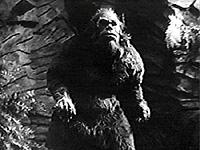 January, 1999 - we’re in the thick of post-production. We’re looking for more shots of the critter- B-movies, stills, newsreels, whatever.
"Warner Bros. after some time
granted us rights on a 1970 Joan Crawford "D-grade" picture named, "Trog". We get local award-winning creature/special effects designer Toby Lindala (X-files and Outer Limits) to be our "Monster Suit" expert, after our legendary "Hollywood creature/fx" person got cold feet and would only let us use his interview in Canadian broadcasts.
After being turned down for some rights
to some major films we replaced them
with some oustandingly tacky Japanese Bigfoot movie scenes. Troma Films ("Surf Nazis must Die") in New York provided brilliant, silly, B-movie footage from their "Capture of Bigfoot". This show features a crazed hunter viewing a Bigfoot in a net: "There’s your superstition, that’s your superstition, and now it’s all mine, ha, ha, ha!" (laughs maniacally). January, 1999 - we’re in the thick of post-production. We’re looking for more shots of the critter- B-movies, stills, newsreels, whatever.
"Warner Bros. after some time
granted us rights on a 1970 Joan Crawford "D-grade" picture named, "Trog". We get local award-winning creature/special effects designer Toby Lindala (X-files and Outer Limits) to be our "Monster Suit" expert, after our legendary "Hollywood creature/fx" person got cold feet and would only let us use his interview in Canadian broadcasts.
After being turned down for some rights
to some major films we replaced them
with some oustandingly tacky Japanese Bigfoot movie scenes. Troma Films ("Surf Nazis must Die") in New York provided brilliant, silly, B-movie footage from their "Capture of Bigfoot". This show features a crazed hunter viewing a Bigfoot in a net: "There’s your superstition, that’s your superstition, and now it’s all mine, ha, ha, ha!" (laughs maniacally).
Accolades
March – October, 1999
We finish the film and start getting it out to festivals. Audiences at Mountainfilm at Telluride respond with peals of laughter and many post-screening questions. The New York International Independent Film Festival awards "Sasquatch Odyssey" a "Best Foreign Documentary Award". The International Documentary Association in Los Angeles picks our film out of more than 500 entries- it is screened alongside eleven other programs at the "Doctober Film Festival". The week-long run in a Los Angeles country theatre makes it eligible for entry into the Academy Award nominations. We hope to pick up some other awards at television festivals across the country.
The creators of the Blair Witch Project spot our poster in a lab in Los Angeles and asked to get in touch with us. Seems they were inspired by the Sasquatch myth and seventies movies about Bigfoot. Who knows where that will lead. In the meantime, the show is airing in Canada on Space TV this summer.
Conclusions
 You couldn’t make up characters like this. Each one of them has come to this phenomenon from a slightly different angle and background. Each one has their own theories about it and yet after forty years, Dahinden for one isn’t certain whether the animal exists. Green says it’s easier to believe in the existence of the creature than it is imagining a worldwide hoax comprised of thousands of sightings and hundreds of anatomically correct footprints. You couldn’t make up characters like this. Each one of them has come to this phenomenon from a slightly different angle and background. Each one has their own theories about it and yet after forty years, Dahinden for one isn’t certain whether the animal exists. Green says it’s easier to believe in the existence of the creature than it is imagining a worldwide hoax comprised of thousands of sightings and hundreds of anatomically correct footprints.
In the end, I’m not entirely convinced that the creature doesn’t exist. There are a lot of un-answered questions…but at this stage, we
have seen the film get national broadcast in Canada-
it aired on CTV and SPACE before the Fall, 2000.
It was then shown on TLC in October 2000
We think it will give people a new perspective on the Big Hairy guy and mankind’s own origins- some funny, some strange, but always intriguing. |